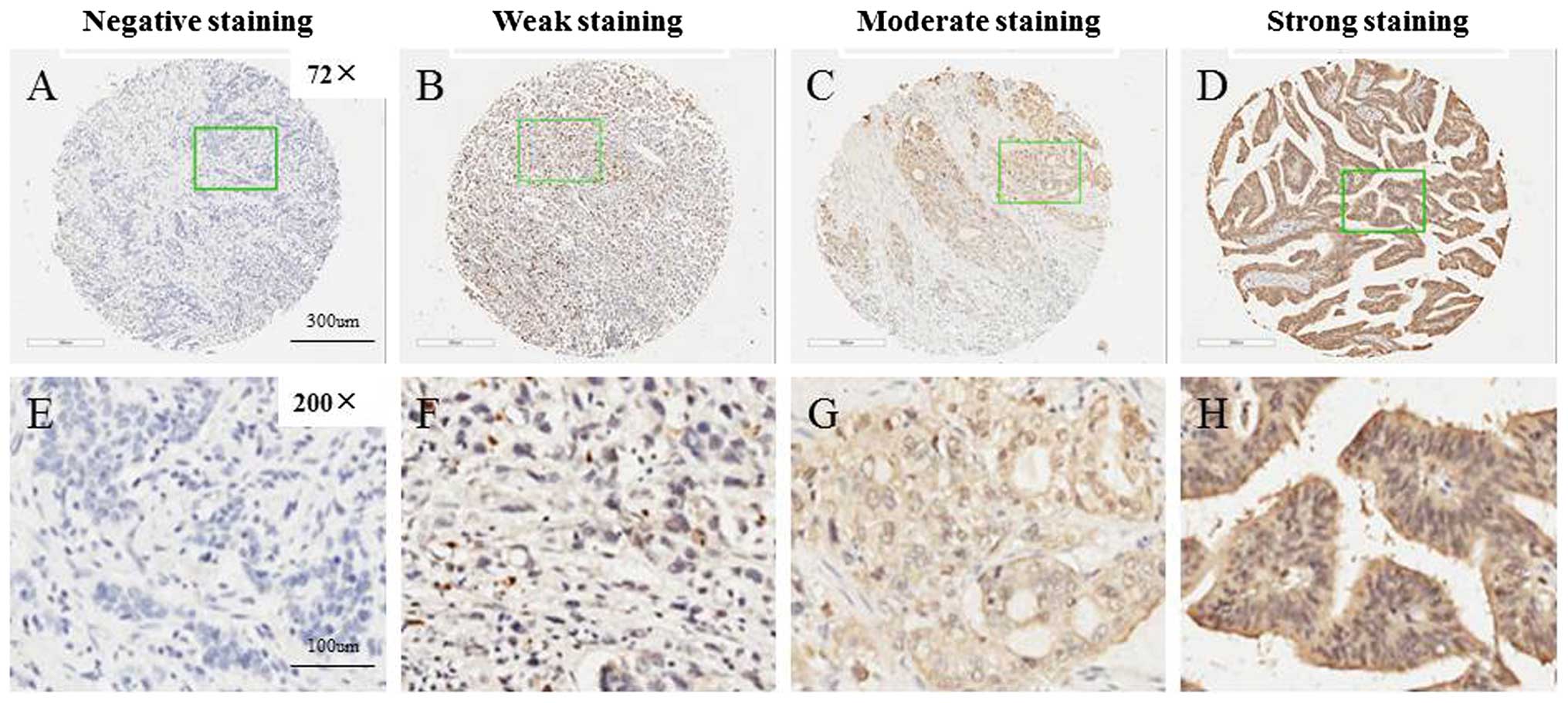|
1
|
Garcia M, Jemal A, Ward EM, et al: Global
Cancer facts & Figures 2007. American Cancer Society; Atlanta:
2007
|
|
2
|
Jemal A, Bray F, Center MM, Ferlay J, Ward
E and Forman D: Global cancer statistics. CA Cancer J Clin.
61:69–90. 2011. View Article : Google Scholar
|
|
3
|
Sun XD, Mu R, Zhou YS, et al: Analysis of
mortality rate of stomach cancer and its trend in twenty years in
China. Zhonghua Zhong Liu Za Zhi. 26:4–9. 2004.(In Chinese).
|
|
4
|
Donato R: S100: a multigenic family of
calcium-modulated proteins of the EF-hand type with intracellular
and extracellular functional roles. Int J Biochem Cell Biol.
33:637–668. 2001. View Article : Google Scholar : PubMed/NCBI
|
|
5
|
Becker T, Gerke V, Kube E and Weber K:
S100P, a novel Ca2+-binding protein from human placenta.
cDNA cloning, recombinant protein expression and
Ca2+-binding properties. Eur J Biochem. 207:541–547.
1992.
|
|
6
|
Arumugam T, Simeone DM, Golen KV and
Logsdon CD: S100P promotes pancreatic cancer growth, survival, and
invasion. Clin Cancer Res. 11:5356–5364. 2005. View Article : Google Scholar : PubMed/NCBI
|
|
7
|
Fuentes MK, Nigavekar SS, Arumugam T,
Logsdon CD, Schmidt AM, Park JC and Huang EH: RAGE activation by
S100P in colon cancer stimulates growth, migration, and cell
signaling pathways. Dis Colon Rectum. 50:1230–1240. 2007.
View Article : Google Scholar : PubMed/NCBI
|
|
8
|
Wang G, Platt-Higgins A, Carroll J, de
Silva Rudland S, Winstanley J, Barraclough R and Rudland PS:
Induction of metastasis by S100P in a rat mammary model and its
association with poor survival of breast cancer patients. Cancer
Res. 66:1199–1207. 2006. View Article : Google Scholar : PubMed/NCBI
|
|
9
|
Bartling B, Rehbein G, Schmitt WD, Hofmann
HS, Silber RE and Simm A: S100A2-S100P expression profile and
diagnosis of non-small cell lung carcinoma: impairment by advanced
tumour stages and neoadjuvant chemotherapy. Eur J Cancer.
43:1935–1943. 2007. View Article : Google Scholar : PubMed/NCBI
|
|
10
|
Austermann J, Nazmi AR, Muller-Tidow C and
Gerke V: Characterization of the Ca2+-regulated
ezrin-S100P interaction and its role in tumor cell migration. J
Biol Chem. 283:29331–29340. 2008.
|
|
11
|
Filipek A, Jastrzebska B, Nowotny M and
Kuznicki J: CacyBP/SIP, a calcyclin and Siah-1-interacting p
rotein, binds EF-hand proteins of the S100 family. J Biol Chem.
277:28848–28852. 2002. View Article : Google Scholar : PubMed/NCBI
|
|
12
|
Shyu RY, Huang SL and Jiang SY: Retinoic
acid increases expression of the calcium-binding protein S100P in
human gastric cancer cells. J Biomed Sci. 10:313–319. 2003.
View Article : Google Scholar : PubMed/NCBI
|
|
13
|
Allred DC, Harvey JM, Berardo M and Clark
GM: Prognostic and predictive factors in breast cancer by
immunohistochemical analysis. Mod Pathol. 11:155–168.
1998.PubMed/NCBI
|
|
14
|
Livak KJ and Schmittgen TD: Analysis of
relative gene expression data using real-time quantitative PCR and
the 2(−Delta Delta C (T)) Method. Methods. 25:402–408. 2001.
|
|
15
|
Siegel R, Naishadham D and Jemal A: Cancer
statistics, 2012. CA Cancer J Clin. 62:10–29. 2012. View Article : Google Scholar
|
|
16
|
Parkkila S, Pan PW, Ward A, et al: The
calcium-binding protein S100P in normal and malignant human
tissues. BMC Clin Pathol. 8:22008. View Article : Google Scholar : PubMed/NCBI
|
|
17
|
Ge F, Wang C, Wang W and Wu B: S100P
predicts prognosis and drug resistance in gastric cancer. Int J
Biol Markers. 28:e387–e392. 2013. View Article : Google Scholar : PubMed/NCBI
|
|
18
|
Jia SQ, Niu ZJ, Zhang LH, et al:
Identifcation of prognosis-related proteins in advanced GC by mass
spectrometry-based comparative proteomics. J Cancer Res Clin Oncol.
135:403–411. 2009. View Article : Google Scholar : PubMed/NCBI
|
|
19
|
Liu J, Li X, Dong GL, et al: In
silico analysis and verification of S100 gene expression in
gastric cancer. BMC Cancer. 8:2612008. View Article : Google Scholar
|
|
20
|
Mátrai J, Chuah MK and VandenDriessche T:
Recent advances in lentiviral vector development and applications.
Mol Ther. 18:477–490. 2010.
|
|
21
|
Arumugam T, Simeone DM, Schmidt AM and
Logsdon CD: S100P stimulates cell proliferation and survival via
receptor for advanced glycation end products (RAGE). J Biol Chem.
279:5059–5065. 2004. View Article : Google Scholar : PubMed/NCBI
|
|
22
|
Basu GD, Azorsa DO, Kiefer JA, et al:
Functional evidence implicating S100P in prostate cancer
progression. Int J Cancer. 123:330–339. 2008. View Article : Google Scholar : PubMed/NCBI
|
|
23
|
Kim JK, Jung KH, Noh JH, et al: Targeted
disruption of S100P suppresses tumor cell growth by downregulation
of cyclin D1 and CDK2 in human hepatocellular carcinoma. Int J
Oncol. 35:1257–1264. 2009.PubMed/NCBI
|
|
24
|
Namba T, Homan T, Nishimura T, Mima S,
Hoshino T and Mizushima T: Up-regulation of S100P expression by
non-steroidal anti-inflammatory drugs and its role in
anti-tumorigenic effects. J Biol Chem. 284:4158–4167. 2009.
View Article : Google Scholar : PubMed/NCBI
|
|
25
|
Oyadomari S and Mori M: Roles of
CHOP/GADD153 in endoplasmic reticulum stress. Cell Death Differ.
11:381–389. 2004. View Article : Google Scholar : PubMed/NCBI
|
|
26
|
Dalton LE, Clarke HJ, Knight J, et al: The
endoplasmic reticulum stress marker CHOP predicts survival in
malignant mesothelioma. Br J Cancer. 108:1340–1347. 2013.
View Article : Google Scholar
|













